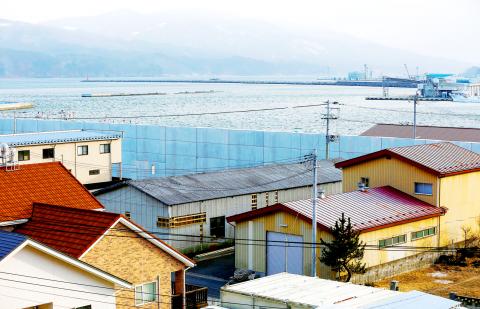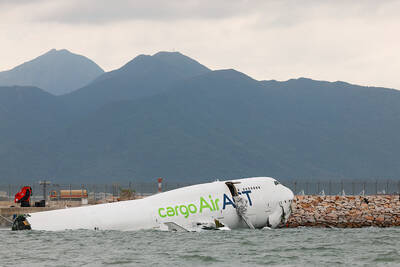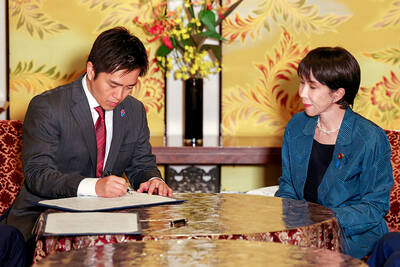When a massive earthquake struck in 2011, Japanese oyster fisherman Atsushi Fujita was working as usual by the sea. Soon afterwards, a huge black wave slammed into his city and killed nearly 2,000 people.
Seven years on, Fujita and thousands like him along Japan’s northeast coast have rebuilt their lives alongside huge sea walls that experts said would protect them if another giant tsunami, which some see as inevitable in a seismically active nation like Japan, is to strike.
The 12.5m concrete wall replaced a 4m breakwater that was swamped in the March 11, 2011, disaster. The earthquake and tsunami, which reached as high as 30m in some areas, killed nearly 18,000 people across Japan and triggered a nuclear meltdown at the Fukushima Dai-ichi nuclear power plant.

Photo: Reuters
“It feels like we are in jail, even though we have not done anything bad,” Fujita, 52, said.
Since the disaster, some towns have forbidden construction in flat areas nearest the coast and have relocated residents to higher land. Others, such as Rikuzentakata, have raised the level of their land by several meters before constructing new buildings.
A common thread, though, is the construction of seawalls to replace breakwaters that were overwhelmed by the tsunami. A total of 395km of walls have been built at a cost of ¥1.35 trillion (US$12.65 billion).
“The seawalls will halt tsunamis and prevent them from inundating the land,” said Hiroyasu Kawai, researcher at the Port and Airport Research Institute in Yokosuka, near Tokyo. “Even if the tsunami is bigger than the wall, the wall will delay flooding and guarantee more time for evacuation.”
Many residents initially welcomed the idea of the walls, but have become more critical over time. Some say they were not consulted enough in the planning stages or that money spent on the walls has meant that other rebuilding, such as housing, has fallen behind.
Others worry the walls will damage tourism.
“About 50 years ago, we came up here with the kids and enjoyed drives along the beautiful ocean and bays,” said Reiko Iijima, a tourist from central Japan, who was eating at an oyster restaurant across from the seawall. “Now, there is not even a trace of that.”
Part of a wall in the city of Kesennuma, which is further south, has windows in it — but these, too, draw complaints.
“They are a parody,” said Yuichiro Ito, who lost his home and younger brother in the tsunami.
“It is just to keep us happy with something we never wanted in the first place,” he added.
Fujita said that while the tsunami has improved oyster farming in the area by stirring up sea floors and removing accumulated sludge, the sea walls could block natural water flows from the land and impact future production.
Many municipalities said the giant walls had to be in place before permission could be granted for reconstruction elsewhere.
“I cannot say things like ‘the wall should be lower’ or ‘we do not need it,’” said Katsuhiro Hatakeyama, who has rebuilt his bed and breakfast business in the same location as before. “It is thanks to the wall that I could rebuild and now have a job.”
However, many find the walls hard to adjust to.
“Everyone here has lived with the sea, through generations,” tuna supply company head Sotaro Usui said. “The wall keeps us apart — and that is unbearable.”

A missing fingertip offers a clue to Mako Nishimura’s criminal past as one of Japan’s few female yakuza, but after clawing her way out of the underworld, she now spends her days helping other retired gangsters reintegrate into society. The multibillion-dollar yakuza organized crime network has long ruled over Japan’s drug rings, illicit gambling dens and sex trade. In the past few years, the empire has started to crumble as members have dwindled and laws targeting mafia are tightened. An intensifying police crackdown has shrunk yakuza forces nationwide, with their numbers dipping below 20,000 last year for the first time since records

CAUSE UNKNOWN: Weather and runway conditions were suitable for flight operations at the time of the accident, and no distress signal was sent, authorities said A cargo aircraft skidded off the runway into the sea at Hong Kong International Airport early yesterday, killing two ground crew in a patrol car, in one of the worst accidents in the airport’s 27-year history. The incident occurred at about 3:50am, when the plane is suspected to have lost control upon landing, veering off the runway and crashing through a fence, the Airport Authority Hong Kong said. The jet hit a security patrol car on the perimeter road outside the runway zone, which then fell into the water, it said in a statement. The four crew members on the plane, which

Japan’s ruling Liberal Democratic Party (LDP) and its junior partner yesterday signed a coalition deal, paving the way for Sanae Takaichi to become the nation’s first female prime minister. The 11th-hour agreement with the Japan Innovation Party (JIP) came just a day before the lower house was due to vote on Takaichi’s appointment as the fifth prime minister in as many years. If she wins, she will take office the same day. “I’m very much looking forward to working with you on efforts to make Japan’s economy stronger, and to reshape Japan as a country that can be responsible for future generations,”

Indonesia was to sign an agreement to repatriate two British nationals, including a grandmother languishing on death row for drug-related crimes, an Indonesian government source said yesterday. “The practical arrangement will be signed today. The transfer will be done immediately after the technical side of the transfer is agreed,” the source said, identifying Lindsay Sandiford and 35-year-old Shahab Shahabadi as the people being transferred. Sandiford, a grandmother, was sentenced to death on the island of Bali in 2013 after she was convicted of trafficking drugs. Customs officers found cocaine worth an estimated US$2.14 million hidden in a false bottom in Sandiford’s suitcase when